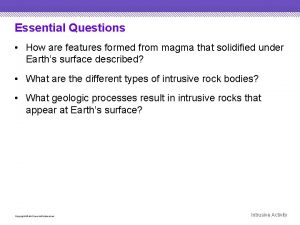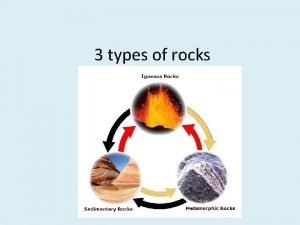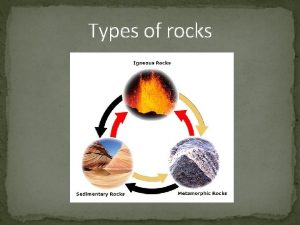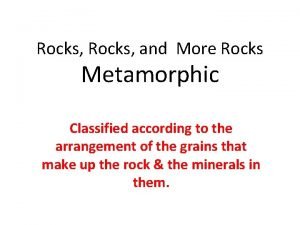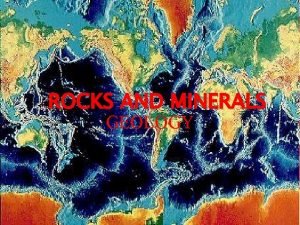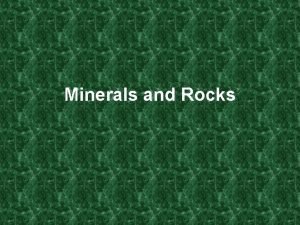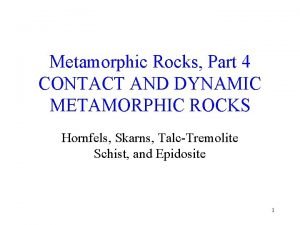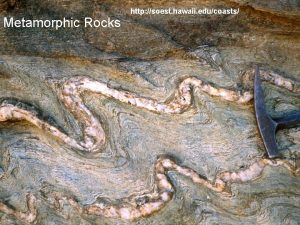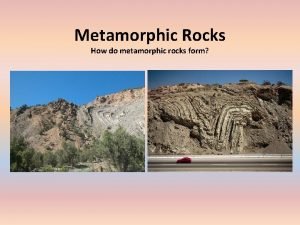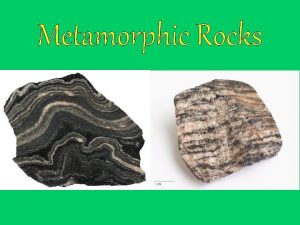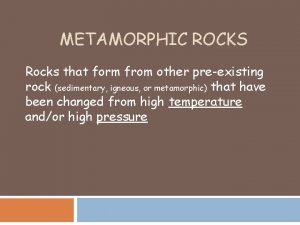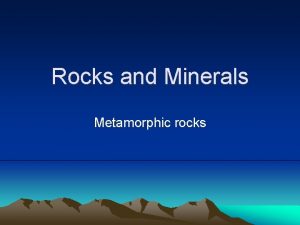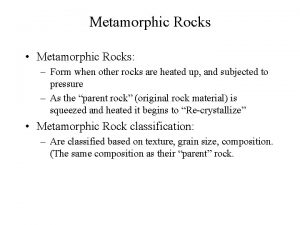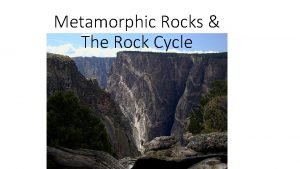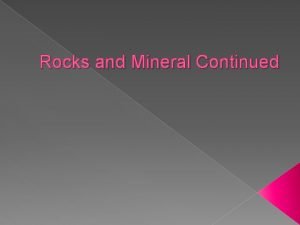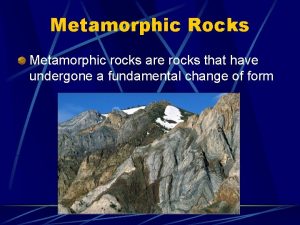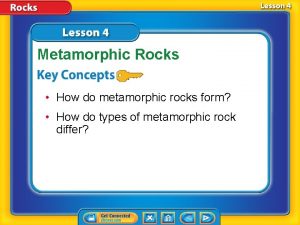METAMORPHIC ROCKS metamorphic rocks form from preexisting rocks






![Textures: according to their structure [classification] 1. foliated = mineral grains flatten and line Textures: according to their structure [classification] 1. foliated = mineral grains flatten and line](https://slidetodoc.com/presentation_image_h2/f29b3794eb09f6277df943861337d7c1/image-7.jpg)






- Slides: 13

METAMORPHIC ROCKS metamorphic rocks = form from preexisting rocks (parent rock) by action of heat, pressure, chemicals, or other environmental conditions

Factors that cause changes: 1. temperature a. when enough sediment piles up on top of a layer the temperature rises enough to decompose minerals b. atoms will recombine to grow new minerals that are stable at higher temperature 2. pressure a. when atoms in crystal are squeezed together very tightly, bonds between them can break b. will reorganize to form a new mineral that is stable at the higher pressure c. can be caused by vertical pressure caused by weight of overlying rock or from compressive forces generated as rocks are deformed during mountain building

3. migrating fluids a. water can move through pore spaces between the grains b. water usually contains dissolved ions c. will flow slowly through rock reacting by decomposing original minerals and replacing them with new ones 4. deformation = change in shape of rock in response to tectonic forces

Formation: (3 ways) 1. regional metamorphism = occurs over area of thousands of square km during periods of tectonic activity a. associated with mountain building, commonly accompanied by deformation b. most common and wide spread type c. produce low grade, intermediate grade, and high grade rocks d. rocks are foliated e. caused by intense pressure and temperature changes

2. contact metamorphism = form from intrusion of hot magma into cooler rocks a. intrusion heat adjacent rock causing old minerals to decompose and new ones to form b. usually seen only along the edges of igneous rock formations c. less area affected d. commonly occurs without deformation e. rocks are nonfoliated

3. hydrothermal metamorphism = form due to migrating hot water and ions dissolved in water a. also called hydrothermal alteration b. most caused by circulating groundwater c. metals can be removed from crustal rocks and deposited locally to form ore = vein d. often forms in the fractures of other rocks e. common near igneous intrusion and near active volcanoes 4. type formed depends on composition of parent rock, temperature and pressure to which it is subjected
![Textures according to their structure classification 1 foliated mineral grains flatten and line Textures: according to their structure [classification] 1. foliated = mineral grains flatten and line](https://slidetodoc.com/presentation_image_h2/f29b3794eb09f6277df943861337d7c1/image-7.jpg)
Textures: according to their structure [classification] 1. foliated = mineral grains flatten and line up in visible parallel bands a. formation: 1) pressure may flatten and push mineral crystals into bands 2) minerals separate due to different densities producing dark & light alternating bands b. minerals that form parallel layers will usually break easily at layers = slaty cleavage c. include slate, phyllite, schist, gneiss shale → schist

2. nonfoliated = mineral grains change, grow, and rearrange but don’t form bands a. commonly occurs without deformation b. will not separate into layers c. fracture into pieces of random size and shape Ex: marble, quartzite, graphite sandstone → quartzite limestone → marble soft coal → graphite

3. porphyroblasts = large crystals that range in size from a few mm to few cm a. found in both contact and regional metamorphism b. commonly forms garnet

Changes that can occur: 1. mineral changes: a. mineral change into new minerals that are stable under new temperature and pressure conditions = solid-state alteration b. rearrangement of mineral grains 2. compositional changes: a. crystals/grains grow and change b. common during contact metamorphism sandstone quartzite

rock cycle = continuous changing and remaking of rocks 1. any of the three types of rock can be changed into another type 2. geologic forces and processes cause rock to change from one type to another and back again 3. changed by weathering, erosion, compaction, cementation, melting, and cooling

4. changes that occur a. sedimentary rock or igneous rock changed by heat and pressure → metamorphic rock b. igneous, sedimentary, and metamorphic rock may weather and erode producing fragments to form sedimentary rock c. metamorphic rock can melt producing magma that later cools forming igneous rock

5. has no beginning and no end 6. a particular body of rock does not always pass through each stage of complete cycle a. shortcuts are common (shown by arrows) 7. expresses concept that rocks are not permanent, but change continually over geologic time
 Lens-shaped pluton with a round top and a flat bottom
Lens-shaped pluton with a round top and a flat bottom Types of igneous rock
Types of igneous rock Igneous rocks metamorphic rocks and sedimentary rocks
Igneous rocks metamorphic rocks and sedimentary rocks Metamorphic rock facts
Metamorphic rock facts 3 types of rocks
3 types of rocks Metamorphic rocks with a layered or banded look are called
Metamorphic rocks with a layered or banded look are called How is a metamorphic rock formed
How is a metamorphic rock formed Metamorphic rocks characteristics
Metamorphic rocks characteristics Nonfoliated def
Nonfoliated def Characteristics of metamorphic rocks
Characteristics of metamorphic rocks Organic sedimentary rocks
Organic sedimentary rocks Dynamic metamorphic rocks examples
Dynamic metamorphic rocks examples Metamorphic grade
Metamorphic grade Metamorphic rocks in hawaii
Metamorphic rocks in hawaii
